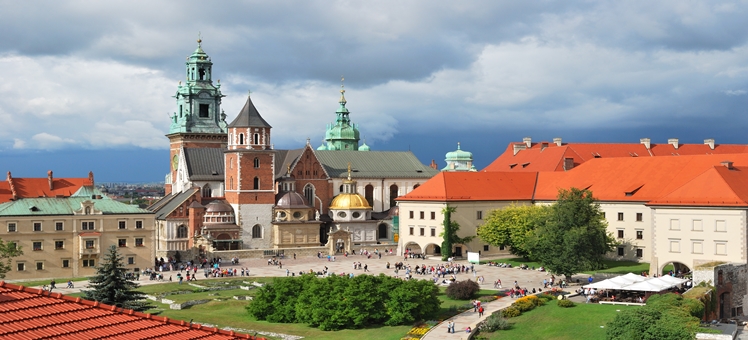
As Poland’s second largest city, it is also one of the oldest too. Settlements here date back to prehistoric times, but the earliest proven date is the early 13th century. Surviving German occupation and the Second World War, much of Krakow’s history is still very much evident today, particularly in the Old Town area of the city. The city was also one of the first sites to be awarded the UNESCO World Heritage status in 1978, giving it another reason to visit.
Wawel CastleThe Castle, located in The Old Town has become a symbol of national identity for both Krakow and Poland and is known as its center piece attraction. The main part of the Renaissance palace dates back to the 15th century and some of it was built in the 11th century. After going through different architectural and stylistic periods from Renaissance to Gothic and suffering a fire, the castle has now been preserved. Restoration work began on the castle after World War I and it is now a museum made up of five sections.
Krakow Zoo
In the Wolski Forest of Zwierzyniec is Krakow Zoo. Over 280 species of animals reside here, with 88 that are endangered and 33 facing extinction. Educate the children with talks and presentations. Enjoy seeing lions, flamingos, lemurs, pygmy hippos and Somali wild ass to name but a few animals found here. Take the number 134 bus from Cracovia Hotel for the easiest way to get to the zoo. You can walk through the forest here too.
Tyniec
Delve into historic and cultural Krakow in a different way. Tyniec was officially made part of Krakow in 1973. Inside the little historic village of Tyniec, is the 11th century Benedictine Abbey. Cycle here (it’s mainly flat), to visit the monks who have perfected making their delicies in food. As the Abbey was built in the 11th century, it had rebuilding work in 1939 and 2006. If you’re not feeling that adventurous, take the number 112 bus from Grunwald roundabout to the center of Tyniec.
The Tatra Mountains
Forming a natural boarder between Poland and Slovakia is the stunning high peaked and impressive Tatra Mountain range. Part of the Carpathian chain, these mountains are very popular with skiers, so head up here in the winter months if you’re keen on your snow-sports, or during spring and summer for some exhilarating walks with worth-while views. Stay in Zakopane which is the main town tourists use for activities here.
Auschwitz
Preserved as a reminder of the persecution of the Jewish people during World War II are the prison camps of Auschwitz and Birkeanau. Also claiming World Heritage Site status, some of the prison blocks are now museums dedicated to the education, teaching and sharing of what happened to those forced to live here. They also serve as a memorial. Situated 60 kilometers outside of the city, this harrowing place is well worth visiting to help understand the pain the Nazi regime inflicted.
Wieliczka Salt Mine
Take a trip to Wieliczka Salt Mine, just 15 kilometres outside of the city. Located in the town of Wieliczka, are the underground mining tunnels. Experience some of the best salt works in the whole of Europe here. Among an actual museum, is a huge chapel intricately made out of salt. Miners down here created it, which is even complete with intricate chandeliers and carvings to decorate the chapel.